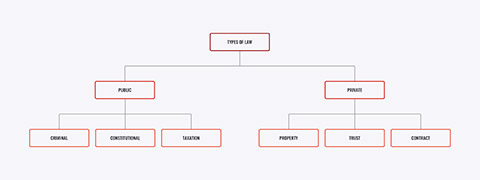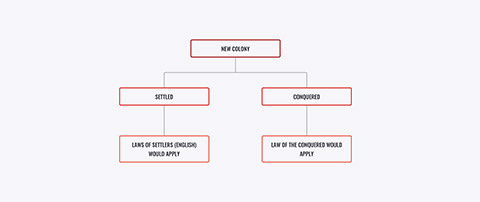Welcome to The Australian Legal System. In this topic, you will learn about:
- The definition of the term ‘law’
- Why there is a need for law
- The outline of the origins of the Australian legal system
- The components of our legal system
- The difference between public and private law
- The historical development of the common law, equity and statute law
- The process by which English law was received into the Australian colonies
- The federal nature of the Australian legal system.
Before we can engage in a discussion of business law, we need to consider what law is and why it is needed. This topic defines the term ‘law’ and explains the need for law. The different branches of the law are considered and the question where ‘business law’ fits into these branches is answered.
Australia has a legal system that comprises various institutions and people. The components of this system are explained in this topic. Australia’s legal system is derived from the British legal system because the British settled Australia in 1788 and at that time, all relevant British common law and statutes were received into the Australian colonies. In 1901, Federation occurred in Australia and this had major implications for our legal system. Federation is explained and the effect this had on the structure of our parliaments and courts examined in the resources provided.
Courts play a key role in resolving disputes but also in making law; case law or judge-made law. Relevant federal and states courts are identified and the concept of a ‘court hierarchy’ is introduced and explained. The doctrine of precedent, developed in England, plays a key role in the way in which courts operate in Australia. The doctrine is explained and its advantages and disadvantages are canvassed.
How to read legislation, a beginner's guide
This 32-page publication from the Western Australian Government attempts to be a beginner’s guide for readers of WA legislation. It explains what legislation is, general observations about reading and interpreting legislation, what case law is, and more. The document can also be downloaded for future reference.

We will start by defining what is the law and why it is needed. There are many definitions of the term ‘law’. In this topic we define law as 'a set of legal rules that govern the way members of a society act towards one another'.
Why do we need law? Laws are required in society to regulate the behaviour of individuals to correspond with what is acceptable to the majority of individuals.
The Australian legal system is made up of different components:
- Institutions
- Laws
- People.
The following table lists each institution, its related laws and the people involved in the institution.
| Institutions | Laws | People |
|---|---|---|
| Parliament | Statute law | Members of parliament |
| Courts | Common law | Judges and magistrates |
| Government departments | Equity | Barristers and solicitors |
| Correctional institutions | Delegated legislation | Court officials Police officers Correctional service officers |
Rule of law
What is meant by 'the rule of law'? Our legal system is based on the ‘rule of law’which requires the law to conform to minimum standards of fairness and to ensure that all persons are treated equally before the law.
Branches of law
There are two branches of law in Australia.
- Private law: Private law allows individuals to take action against others (for example, to sue one another for breach of contract or negligence to obtain compensation).
- Public law: Public law allows the state to take action to enforce the laws which support our society as a whole (e.g. criminal law where a police prosecutor will proceed against a defendant). The following diagramme identifies specific types of law that fall under the categories public law and and private law.

How can we differentiate between civil law and criminal law?
Civil law: Civil law equals private law and includes:
- Law of torts
- Contract law
- Property law.
Criminal law: Criminal law covers offences with which an individual can be charged.
The key distinctions between civil law and criminal law are briefly described in the following table.
| Type of law | Parties | Aims | Outcome | Proof |
|---|---|---|---|---|
| Civil law | Plaintiff commences action against defendant | Compensation for the loss or injury suffered by the individual | Damages, specific performance, or an injunction | On the balance of probabilities |
| Criminal law | Government commences proceedings against defendant | Punishment of the offender, deterrence of the offender and others who may offend the community | Prison terms, fines, good behaviour bonds, community service orders | Beyond a reasonable doubt |
The courts
Because Australian is a federal system it has both federal,state and territory courts. These courts are structured in a hierarchy with one court being regarded as higher than another. The following diagram shows details of the federal and state/territory court hierarchy in Australia.

Watch the following video which will expand on some of the points raised and provides a good overview of the Australian court system.
The current Australian legal system can be considered the product of three distinct branches of English law:
- Common law: Judges follow decisions made and recorded in similar, previously decided cases. The remedy is damage
- Equity: Judges follow decisions that have been made in similar, previously decided cases but may also consider issues of fairness. The remedies are broader.
- Statute law: Statute law refers to legislation or Acts passed by parliament.
What is the doctrine of reception?
The following illustration shows how laws were applied in a new colony (for example, when Australia was colonised by England).

Legislation that dealt with reception of English law in colonies such as Australia included:
- 4 Geo IV c96 (1823): This legislation created the Legislative Council and provided that members were nominated by the governor. It also empowered enactment of legislation consistent with English law, allowed for the creation of an executive council and authorised the issue of letters patent.
- The Third Charter of Justice—1824: The Third Charter of Justice—1824 established the Supreme Court of New South Wales.
- The Australian Courts Act 1828: The Australian Courts Act 1828 provided that all suitable statutes and common law in force in England as at 25 July 1828 should be applied in New South Wales and Van Diemen’s Land. It also provided that laws passed after 25 July 1824 did not automatically apply to colonies and Van Diemen’s Land.
- The Colonial Laws Validity Act 1865 (UK): The Colonial Laws Validity Act 1865 (UK) provided that colonial legislation would be void only if it was repugnant with British laws extending to the colonies.
The colonies agreed to hand over certain powers to form a central government. Legislation that led to federation and the establishment of the Commonwealth of Australia, included:
- The Commonwealth of Australia Constitution Act 1900 (UK): The Commonwealth of Australia Constitution Act 1900 (UK) was the legislation that created the Commonwealth of Australia (the Commonwealth Parliament).
- The Statute of Westminster 1931 (UK): The Statute of Westminster 1931 (UK) ensured independence of Commonwealth Parliament from British Parliament. It was adopted in Australia by the Statute of Westminster Adoption Act 1942 (Cwlth). The Statute meant no British Act should extend to a dominion unless it had requested and consented to the statute. The total separation did not come until 1986.
- The Australia Act 1986 (Cwlth and UK): The Australia Act 1986 (Cwlth and UK) repealed the Colonial Laws Validity Act 1865. It also abolished appeals from Australian courts (for example, state Supreme Courts) to the Privy Council in England and provided that states could not legislate on foreign affairs.
- The Privy Council (Appeals from the High Court) Act 1975 (Cwlth): Abolished appeals from the High Court to the Privy Council.

Before we look further at the impact and implications of the Mabo and Wik cases in Australia, review the outcomes of the Mabo v. Queensland (No. 2) (1992) 175 CLR 1 case and the Native Title Act 1993 (Cwlth).
| Case or legislation | Outcome |
|---|---|
| Mabo v. Queensland (No. 2) (1992) 175 CLR 1 | Mabo v. Queensland (No. 2) (1992) 175 CLR 1 overturned the doctrine of terra nullius and recognised the form of native title to land |
| The Native Title Act 1993 (Cwlth) | The Native Title Act 1993 (Cwlth) provided for the statutory recognition of native title and established the Native Title Tribunal. |
The Mabo case
The ‘Mabo Day’ video below expands on these points and outlines the removal of Terra Nullius (‘nobody’s land’) from Australian law. It also explores the recognition of Aboriginal peoples preceding white settlement by the High Court and the rights of their descendants.
The Wik case
There are two key decisions made by the State of Queensland and the Commonwealth that impacted Aboriginal and Torres Strait Islander peoples, briefly described in the following table.
| Case or legislation | Outcome |
|---|---|
| Wik Peoples v Queensland (1996) 187 CLR | Wik Peoples v Queensland (1996) 187 CLR decided native title rights could co-exist with pastoral leases. |
| Native Title Amendment Act 1997 (Cwlth) | The Native Title Amendment Act 1997 (Cwlth) established that:
|
Watch the following video that provides an overview of the Wik vs Queensland case.
Amendments to native title legislation
Amendments to native title legislation were made in the following legislation:
- The Native Title Amendment Act 2007 (Cwlth): The Native Title Amendment Act 2007 (Cwlth) responded to government reviews and recommendations and ensured native title processes are effective and efficient
- The Native Title Amendment (Technical Amendments) Act 2007 (Cwlth): The Native Title Amendment (Technical Amendments) Act 2007 (Cwlth)clarified or improved existing provisions.

Read through the Fact Sheet 20: The Australian System of Government. The fact sheet provides a useful summary of the Australian parliamentary system. Students should appreciate the doctrine of the separation of powers that is explained and also the role the Queen plays in the Australian legal system.
Australia has a federal system of government. Both the federal government and the state governments have law-making powers. The Commonwealth of Australia Constitution Act 1900 makes provision for the division of law making. Section 51 lists subject matters in respect of which the Commonwealth Parliament has power to legislate, some being:
- taxation
- defence
- currency, coinage and legal tender
- marriages
- external affairs.
Law-making powers
There are different types of law-making powers in Australia.
Concurrent power
- Section 51 allows Commonwealth and states to share powers, for example, taxation and banking.
- Section 109 allows that if there is conflict, federal legislation stands.
Exclusive power
- Section 52(i) allows that the Commonwealth has sole authority to legislate in some areas.
- Section 90 allows specific areas of customs, excise and bounties.
Residual power
States have sole power to legislate in other areas not prohibited by the Constitution.
Laws made by parliament
There are several stages in the passage of a bill. These can be shown as:
Stage 1: Introduction of Bill by minister in the first house
Stage 2: First reading
- Name of Bill
- Date of second reading
Stage 3: Second reading
- Minister explain general principles of Bill
- General debate
Stage 4: Committee stage
- Committee formed to examine and debate
- Amendments made
Stage 5: Third reading
- Vote on Bill
- Moves to second house of parliament
In the second house of parliament there are two outcomes:
- Acceptance: Royal assent > Act of Parliament > Notified in the Government Gazette.
- Non-acceptance: Non-acceptance could lead to a double dissolution.
Watch the following video About Parliament: Making a law to learn more about this process.
Delegated (subordinate) legislation
Delegated (subordinate) legislation is made under the authority of an Act of Parliament. Types of delegated (subordinate) legislation include:
- Regulations
- By-laws
- Rules
- Ordinances.
Delegated (subordinate) legislation can occur because of time or expertise limitations. They may be overruled by the government that enacted legislation giving authority.
End of topic forum
There are three forum threads for this topic:
- Introduce yourself: The first thread asks you to introduce yourself to the other students.
- Johncock case: This activity provides an opportunity to read a case decided by a court and to see the doctrine of precedent in operation and gain insight into how a judge decided a case and the reasoning employed. You will read the decision of the Supreme Court of South Australia in the decision of Johncock and Another v Port Lincoln Football League Incorporated [2013] SASC 143 (10 September 2013) and answer 10 questions in the forum.
- Partnership Act: This activity provides an opportunity to examine in detail the structure of an Act of Parliament and answer eight questions. This is important because statutes (Acts of Parliament) are a main source of Australian law. You will learn how an Act is set out and will be able to examine common features such as an interpretation section, parts, divisions, sections and sub-sections. At this stage we are not so much concerned with the content of the statute but its structure.
Please select the 'Forum' at the end of your module (which can be found within your navigation menu) and follow the instructions for each question pertaining to Topic 1 within the forum.
Signed, Sealed and Delivered. Valid notices by email but when are they received?
This article asks the question How safe is it to use email as a means of communication for formal notices under contracts? It provides recent cases that highlight some unintended outcomes and risks.
Useful websites for your studies
- Australasian Legal Information Institute
- Parliament of Australia
- Parliament of South Australia
- High Court of Australia
- Federal Court of Australia
- South Australian Courts Administration Authority
- The Law Handbook Online (South Australian Legal Services Commission)
- The Partnership Act 1891 (SA)
- The Competition and Consumer Act 2010 (Cth)

